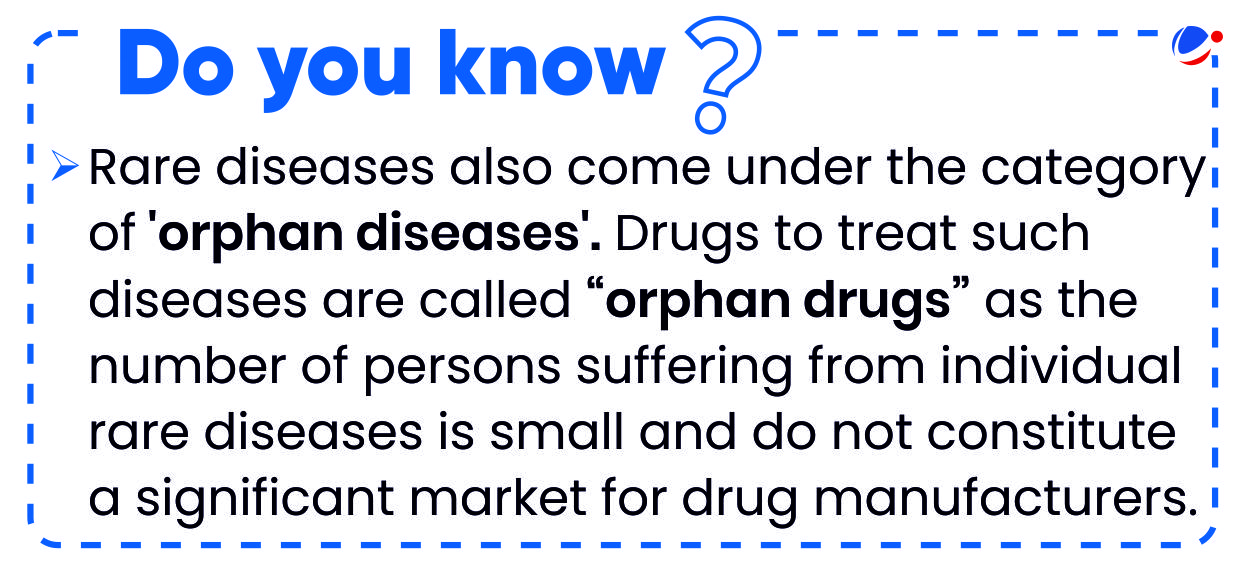Why in the News?
India's Central Drugs Standard Control Organisation (CDSCO) approves first anti-complement therapy for rare diseases
More on the News

- Earlier, Delhi High Court had issued several directives to the Union Government aimed at improving the funding and treatment infrastructure for rare diseases in India.
- Also, in Master Arnesh Shaw v. Union of India & Anr. Case, the Delhi High Court underscored that patients, particularly children, suffering from rare diseases should not be denied treatment solely due to the prohibitive cost of drugs or therapies.
- The Court further affirmed that the Right to Health, as an integral component of the Right to Life under Article 21, must be upheld universally, including for those with rare diseases.
What are Rare Diseases?
- World Health Organization (WHO) defines rare disease as often debilitating lifelong disease or disorder with a prevalence of 1 or less, per 1000 population. For E.g. Fanconi Anemia, Osteopetrosis etc.
- However, different countries have their own definitions to suit their specific requirements and in context of their own population, health care system and resources.
- Currently, 63 Rare Diseases are listed under National Policy for Rare Disease 2021 (NPRD, 2021), classified under 3 groups (see infographic).
- The disease list in these groups is updated periodically based on scientific advances and recommendations of Central Technical Committee for Rare Diseases.
Classification of Rare Diseases in India (as per NPRD 2021) | ||
Group 1: Amenable to one-time curative treatment | Group 2 Long-term treatment needed with relatively lower costs and documented benefits | Group 3 Definitive treatment is available but challenges in optimal patient selection for benefit, very high cost and lifelong therapy |
E.g., Disorders amenable to organ transplantation like Urea cycle disorders, Fabry disease etc. | E.g., Disorders managed with special dietary formulae like Phenylketonuria, Homocystinuria etc. | E.g., Gaucher Disease, Pompe Disease etc. |
Initiatives to tackle rare diseases
|
Issues in managing Rare Diseases in India
- High prevalence rate: India accounts for one-third of global rare disease cases, with over 450 identified diseases.
- Limited clinical trials: With over 8000 global clinical trials for rare diseases underway, hardly 80 (<0.1%) of them have a site in India.
- Lack of definition: India currently lacks sufficient epidemiological data for a standard definition.
- Low budgetary support: The 2023-24 Budget allocation for rare diseases stands at ₹93 crore, still low despite gradual increases.
- Underutilization of funds by Centre of Excellences: Over ₹47 crore of the ₹71 crore allocated for financial assistance to 11 CoEs remains unused.
Other Challenges associated with Rare Disease | |||
Delayed diagnosis/ Misdiagnosis | Limited treatment options | Limited R&D | Impact on patients |
| 95% rare diseases have no approved treatment |
|
|
Way Forward
- Implement Key directives of the recent Delhi High Court judgement:
- Establish National Fund for Rare Diseases (NFRD) with ₹974 crore allocation for FY 2024-25 and FY 2025-26.
- Allocated funds must not lapse or be refunded due to non-utilization.
- NFRD shall be administered by National rare disease cell consisting of one or more nodal officers in Ministry of Health and Family Welfare (MoH&FW).
- National Rare Diseases Committee (NRDC), established in 2023, will continue its work for an additional five years, chaired by the Director General of the ICMR.
- Develop and operationalize centralized National Rare Disease Information Portal (within 3 month) for patients, doctors, and the general public with facilities such as patient registry, available treatments etc.
- Instruct Drugs Controller General of India (DCGI) and Central Drugs Standard Control Organization (CDSCO) to monitor local and global clinical trials to ensure more patients can be enrolled.
- Create dedicated Fast Track approval process for rare disease drugs and therapy.
- Pharmaceutical companies importing rare disease therapies to submit detailed plan to MoH&FW and NRDC within 90 days for establishing local manufacturing/distribution facilities in India.
- Enable Corporate Social Responsibility (CSR) contribution by companies, including Public Sector Undertakings by adding Donations for rare diseases in Schedule VII of the Companies Ac.
- Flexibility in upper limit of ₹50 lakhs under NPRD, 2021 for the treatment of rare diseases in Group 3 category, as per the recommendation of NRDC.
- Establish National Fund for Rare Diseases (NFRD) with ₹974 crore allocation for FY 2024-25 and FY 2025-26.
- Other steps that can be taken
- Strengthen epidemiological and prevalence data research to ocusingio definition of Rare Disease.
- National Registry to address this data gap, a hospital-based National Registry to collect epidemiological data on rare diseases across India has been initiated.
- Expand CoEs, especially in underserved region would improve accessibility to timely diagnosis and treatment.
- Incentivize domestic drug manufacturing under the Production-Linked Incentive Scheme.



